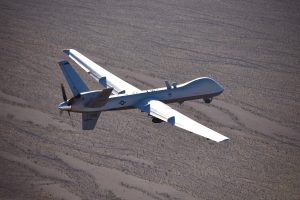The U.S. Air Force (USAF) will temporarily deploy eight MQ-9 Reaper unmanned aerial vehicles (UAVs) to the Japan Maritime Self-Defense Force (JMSDF)’s Kanoya Air Base in Kagoshima Prefecture on Kyushu, or the southernmost of Japan’s main islands, from late October, the Ministry of Defense (MoD) in Tokyo has announced.
The move will mark the first time that the Reaper is deployed to Japan, demonstrating the U.S. commitment to Japan’s defense. The MoD hopes the UAVs will be beneficial to Japan’s security by strengthening maritime surveillance around the nation, given the increasingly active maritime activities by surrounding countries such as China and Russia.
The Reapers are expected to be deployed at the base for one year. About 150-200 U.S. service personnel will stay at hotels in Kanoya City to operate the medium-altitude, long-endurance (MALE) surveillance aircraft, an official of the Kanoya City Hall in charge of the deployment told The Diplomat on October 6.
Some are expecting that the deployment will bring about positive economic effects on the city, while others are questioning whether the deployment will really end after one year, the city official admitted to The Diplomat.
The MoD said in documents that the temporary deployment of the UAVs is aimed at conducting intelligence-gathering activities in waters near Japan with a central focus on the East China Sea ‒ an implicit reference to China’s increasing assertiveness in the region, especially around the disputed Senkaku/Diaoyu Islands, which are controlled by Tokyo but also claimed by Beijing, as well as Taiwan.
Japan’s Defense Minister Hamada Yasukazu and U.S. Defense Secretary Lloyd Austin said in a statement after their first in-person talks in Washington on September 14 that they “welcomed the progress towards the temporary deployment of USAF MQ-9s to JMSDF Kanoya Air Base.” They agreed that the two nations would “jointly analyze information acquired by Japanese and the US assets including MQ-9s.”
In particular, Hamada said that the temporary deployment of MQ-9s contributes to the deepening of intelligence, surveillance and reconnaissance (ISR) activities by unmanned aerial vehicles of the Japan Self-Defense Forces (JSDF).
As Beijing expands its activities in the East China Sea, Tokyo is striving to enhance the defense capabilities on Japan’s southwestern Nansei island chain, which spans about 1,200 km from Kagoshima to Okinawa, stretching southwest toward Taiwan.
It is possible that the UAVs will also be used to keep tabs on North Korean activities, including Pyongyang’s nuclear and ballistic missile programs.
According to Janes Defence Weekly, the Reaper has a maximum take-off weight of 4,760 kg; a payload of 1,701 kg; a cruise speed of 200 knots (370 km/h); a range of 1,000 nautical miles (1,852 km); a service ceiling of 50,000 ft; and an endurance of 27 hours. It carries an electro-optical/infrared sensor turret for ISR duties.

































